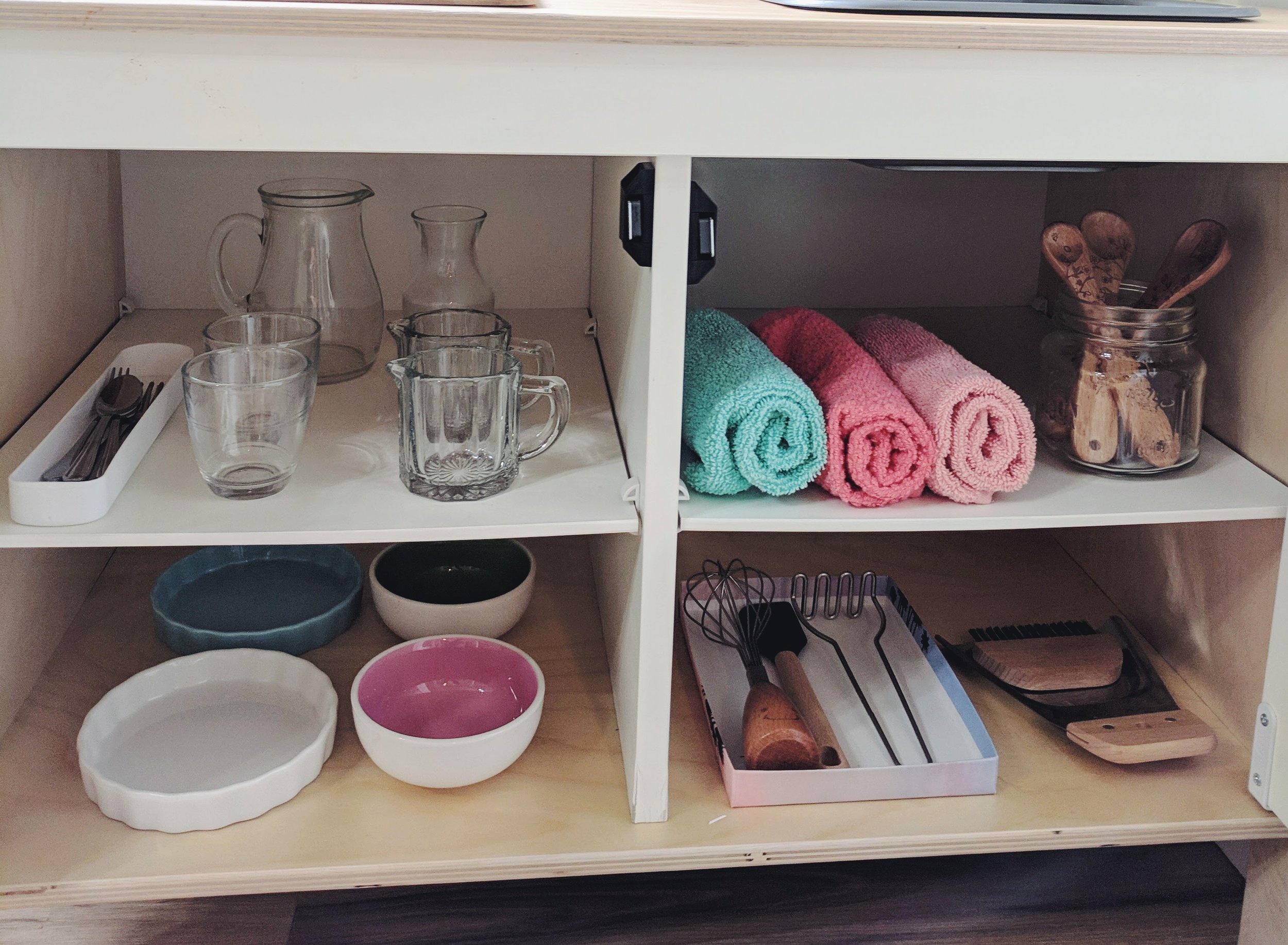Transform Your Space: Essential Montessori Tips for a Nurturing Home Environment
courtesy of montessoriinreallife.com
In today’s fast-paced world, creating a peaceful and intentional space at home is more important than ever. For parents who want to foster independence, creativity, and curiosity in their children, the Montessori method offers an inspiring blueprint. Rooted in respect, hands-on learning, and purposeful design, Montessori principles transform everyday living spaces into nurturing environments that support both growth and learning.
Imagine a home where every item and every corner is intentionally arranged to encourage exploration and self-directed activity. With thoughtful planning, you can say goodbye to clutter and chaos and welcome a space that nourishes your child’s natural development. In this post, we’ll delve into ten essential Montessori tips that will empower you to create a nurturing home environment, transforming your living space into a haven of creativity, order, and inspiration.
The Importance of a Nurturing Home Environment
A child’s early years are fundamental in shaping their perception of the world. The environment in which they learn and grow plays a crucial role in their physical, emotional, and cognitive development. When you create a home that is calm, orderly, and full of learning opportunities, you are setting the stage for your child to become an independent thinker and a confident learner.
Montessori education emphasises the power of a nurturing environment. By ensuring that every element of your home supports curiosity and learning, you provide a safe and stimulating space where your child can thrive. Whether it’s through designated learning corners, open shelves, or natural materials, a well-organised home helps children develop essential skills like decision-making, organisation, and responsibility.
A nurturing home environment also nurtures emotional well-being. When children are surrounded by calm, orderly spaces, they experience reduced stress and anxiety, allowing their natural curiosity to flourish. As you transform your home using these Montessori-inspired tips, you’ll notice not only an improvement in your child’s behaviour and focus but also in their overall happiness and sense of security.
Courtesy of montessoriinreallife.com
Key Principles of Montessori Design
Montessori design is founded on simplicity, accessibility, and natural order. These principles are not about strict rules; instead, they encourage an environment where both parents and children can feel relaxed and supported. Here are the key principles that can guide you as you transform your home:
1. Child-Centred Spaces
The essence of Montessori design is to create spaces that are tailored to a child’s needs. This means ensuring that your child can easily reach, use, and interact with the tools and toys that help in their learning process. By designing child-sized furniture, low shelves, and accessible storage, you empower your little ones to explore and learn independently. When children see that the environment is made just for them, they feel a sense of belonging and ownership.
2. Order and Simplicity
Simplicity is at the heart of Montessori philosophy. A clutter-free space is not only visually appealing but also essential for fostering concentration and mindfulness. Removing unnecessary items and creating a clean, organised environment allows your child to focus on learning and discovery. Order in the home minimises distractions and creates a calming atmosphere that encourages children to immerse themselves fully in play and study.
3. Use of Natural Materials
Natural materials like wood, cotton, and stone bring warmth and a sensory-rich experience to any space. The tactile quality of these elements has a soothing effect and can help ground children as they learn. Incorporating natural materials into your home design—whether through furniture, toys, or decorative elements—connects children with nature and encourages a healthier, more balanced lifestyle.
4. Freedom of Movement
A truly Montessori home respects a child’s need to move and explore freely. Open spaces that allow for fluid movement empower children to navigate their environment at their own pace. When children can move without constraints, they learn to trust their instincts and develop physical coordination. Open layouts with defined activity areas strike the perfect balance between freedom and structure.
5. Hands-On Learning
Montessori is all about tactile and experiential learning. Providing opportunities for children to engage directly with learning materials builds practical skills and deepens understanding. Whether it’s through interactive play, art, or everyday tasks, hands-on learning makes abstract concepts tangible and relevant. Incorporate elements such as baskets, trays, and activity stations that invite children to learn by doing.
Creating a Child-Centred Space
Courtesy of sprout-kids.com
When you design your home with a child-centred approach, you invite your child to take an active role in their learning journey. A child-centred space is not only accessible but also encourages decision-making and self-reliance. Here are several strategies to consider:
Lower Furniture and Accessible Storage
Children thrive in environments where they feel included. When furniture such as chairs, tables, and storage units is designed at their level, it sends a clear message: this is your space, and you can manage it. Low shelves make it easier for children to access books, toys, and other learning materials without constant adult intervention. This independence builds self-confidence and encourages a sense of responsibility.
Designated Learning Zones
Creating dedicated spaces for various activities can have a profound impact on your child’s development. Consider setting up a cosy reading nook, an art corner with accessible supplies, or a small area for hands-on science experiments. By defining specific zones, you not only organise the space but also create a clear structure that helps your child transition smoothly between activities. Each zone becomes a mini-classroom where your child can engage in focused, uninterrupted learning.
Flexible Layouts
A child’s interests and needs evolve over time, so it’s important to design spaces that can adapt accordingly. Flexible layouts that allow for rearranging furniture or switching out activities will ensure that the space remains relevant and engaging. For example, a low table can serve as a crafting station one day and a puzzle area the next. Embracing flexibility in your design means that the environment will continue to support your child’s growth as they develop new skills and interests.
Incorporating Nature and Natural Elements
One of the hallmarks of Montessori design is the integration of nature into everyday living. Natural elements are not only aesthetically pleasing but also provide a calming, grounding effect that benefits both children and adults.
Letting in Natural Light
Natural light is a vital component of any healthy living space. Placing activity areas near windows maximises exposure to sunlight, which can improve mood, boost energy levels, and enhance concentration. The soft, ever-changing light throughout the day creates a dynamic backdrop that keeps the environment feeling fresh and alive. Consider using light, airy curtains that diffuse sunlight while still allowing ample brightness to fill the room.
Bringing the Outdoors Inside
Plants and natural décor are more than just decorative elements—they offer sensory stimulation and a connection to the earth. Incorporating potted plants, fresh flowers, or even a small indoor garden can make your home feel more vibrant and alive. Taking care of these plants can become a shared family activity, teaching children responsibility and nurturing a respect for nature. Natural textures, such as wooden toys or cotton fabrics, add another layer of sensory experience that can soothe and engage young minds.
Celebrating Organic Materials
There is something inherently comforting about natural materials. When children interact with wooden toys, cotton bedding, or woollen rugs, they engage multiple senses at once. These materials have a warmth and authenticity that synthetic alternatives simply cannot match. Consider replacing plastic items with natural alternatives wherever possible. Not only does this create a more inviting environment, but it also fosters an appreciation for quality and sustainability in your child.
Organising Spaces for Independence
Courtesy of reddit forum: r/Montessori
An organised home is the cornerstone of a successful Montessori environment. When everything has its place and is easily accessible, children learn the importance of order and are encouraged to take responsibility for their surroundings.
Declutter for Calm
A cluttered space can overwhelm the senses and hinder learning. Start by evaluating the items in each room and keeping only those that are purposeful and contribute to the learning environment. When you remove unnecessary clutter, you create a calm, peaceful space that invites focus and relaxation. This simplicity helps children concentrate on their activities without distraction.
Open Storage Solutions
Open storage systems, such as baskets, bins, and low shelves, are ideal for a Montessori home. These solutions not only make it easy for children to see and select what they need but also teach them to organise and care for their belongings. Clearly labelled storage units further enhance this learning process by encouraging children to return items to their rightful place after use. The visual organisation of open storage is both practical and aesthetically pleasing.
Regular Rotation of Materials
To keep your child’s interest alive and prevent overstimulation, consider rotating toys and learning materials periodically. This strategy not only maintains an element of surprise and novelty but also ensures that your child can focus on a few items at a time. Rotating materials helps prevent sensory overload and keeps the learning experience fresh and engaging. It also provides an opportunity for periodic reorganisation, reinforcing the importance of maintenance and care in their environment.
Practical Tips to Implement Montessori at Home
Transitioning your home to a Montessori-inspired environment might seem like a daunting task, but it doesn’t require a complete overhaul. Instead, you can start with small, intentional changes that gradually build into a complete transformation. Here are some practical tips to help you get started:
Tip 1: Begin with One Room
Start with the room where your child spends most of their time, such as their bedroom or play area. Focus on one space at a time to ensure that you can fully integrate Montessori principles without feeling overwhelmed.
Tip 2: Involve Your Child
Whenever possible, involve your child in the process of organising and decorating their space. Let them choose colours, arrange items, or even help with simple tasks like watering plants. This participation not only makes them feel valued but also teaches important skills such as decision-making and responsibility.
Tip 3: Prioritize Function Over Fashion
While aesthetics are important, functionality is key. Choose items that are durable, easy to clean, and designed with your child’s needs in mind. Low-maintenance, natural materials often work best in a Montessori setting, as they combine practicality with a warm, inviting look.
Tip 4: Set Clear Zones
Define specific zones within each room for different activities. Whether it’s a reading nook, a creative arts area, or a quiet corner for puzzles, having dedicated spaces encourages structured play and helps children transition smoothly between activities.
Tip 5: Embrace Minimalism
Simplicity is a guiding principle in Montessori design. Avoid overcrowding spaces with too many toys or distractions. Instead, focus on quality and purpose. This minimalist approach not only reduces clutter but also makes it easier for children to focus and engage deeply with the materials they have.
The Benefits of a Montessori-Inspired Home
Courtesy of www.wholechildhome.com
Transforming your home into a Montessori environment brings a wealth of benefits—not just for your child, but for the whole family. Here are a few of the most significant advantages:
Enhanced Independence
When children have access to their own space and tools, they quickly learn how to do things for themselves. This independence fosters confidence and self-sufficiency, laying a strong foundation for lifelong learning and problem-solving.
Improved Focus and Concentration
An organised, clutter-free space is less distracting and more conducive to focused learning. Montessori design encourages mindfulness by creating an environment that promotes concentration. Children learn to immerse themselves in activities without the constant pull of distractions.
Emotional Well-Being
A nurturing home environment, grounded in order and natural elements, contributes significantly to emotional stability. When children feel secure in their surroundings, they are better equipped to handle challenges, express their creativity, and form healthy relationships.
Family Bonding
Implementing Montessori principles often involves the entire family. From choosing décor to organizing spaces, these changes provide opportunities for collaboration and bonding. Involving children in the process not only empowers them but also creates a shared sense of purpose and accomplishment.
Final Thoughts: Embracing the Montessori Journey
Transforming your space with Montessori principles is a journey that evolves over time. There is no one-size-fits-all approach, and every family’s needs are unique. The beauty of the Montessori method lies in its flexibility; you can adapt the principles to suit your child’s interests, developmental pace, and your family’s lifestyle.
As you begin to incorporate these ten essential tips, remember that small, deliberate changes can have a profound impact. Whether it’s by creating child-centred spaces, using natural materials, or simply decluttering your home, each step you take is a step toward nurturing a more mindful and enriching environment.
A Montessori-inspired home not only supports your child’s growth but also transforms your daily life into a series of learning moments, fostering creativity, responsibility, and joy. As your child becomes more involved in their own learning journey, you’ll witness the power of a thoughtfully designed space to inspire and empower. Embrace the changes gradually, and enjoy the process of seeing your home evolve into a sanctuary that truly reflects the values of respect, independence, and lifelong learning.
Are you ready to start your Montessori journey at home? With a few mindful adjustments, you can create a space that is not only functional and organised but also a loving, nurturing haven where your child—and your whole family—can flourish.
Creating a nurturing home environment is a continuous process. Each tip you implement lays the groundwork for a space that supports both learning and emotional well-being. As you transform your home, you’re also laying a solid foundation for your child’s future, one that is filled with curiosity, creativity, and confidence.
Remember, the Montessori method is more than just a design strategy—it’s a way of life that encourages independence, fosters connection with nature, and creates opportunities for hands-on learning. Even small changes, when done with intention, can lead to a profound transformation in how your child experiences the world around them.
So, take a deep breath, embrace the process, and start transforming your home today. Your efforts will not only make your space more beautiful and organised but will also empower your child to thrive in an environment that nurtures every aspect of their development.
Transform your home into a sanctuary where learning and living coexist harmoniously, and witness the incredible impact that a nurturing environment can have on your family’s journey. Happy transforming!
Anna Unger








